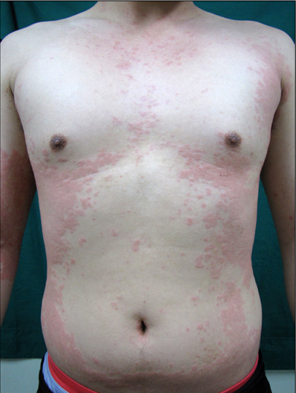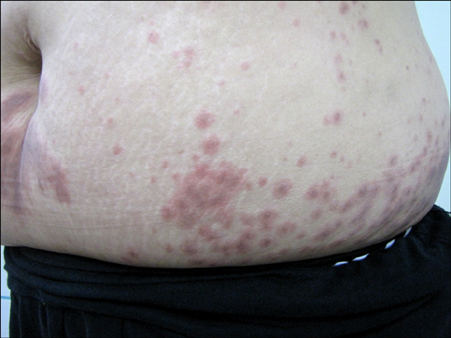Ann Dermatol.
2012 Aug;24(3):319-323. 10.5021/ad.2012.24.3.319.
Clinical Features of Systemic Contact Dermatitis Due to the Ingestion of Lacquer in the Province of Chungcheongnam-do
- Affiliations
-
- 1Department of Dermatology, Soonchunhyang University College of Medicine, Cheonan, Korea. dermsung@schmc.ac.kr
- KMID: 2265305
- DOI: http://doi.org/10.5021/ad.2012.24.3.319
Abstract
- BACKGROUND
Lacquer contains an allergen, which can cause severe contact dermatitis. Systemic dermatitis resulting from the ingestion of lacquer is quite common in Korea, until now.
OBJECTIVE
The purpose of this study is to elucidate the clinical features and laboratory findings of systemic contact dermatitis (SCD), due to the ingestion of lacquer in Chungcheongnam-do.
METHODS
We retrospectively reviewed the medical records of 33 patients with SCD, after ingestion of lacquer from Soonchunhyang University Hospital in Cheonan, over a 6-month period.
RESULTS
In this study, 33.3% of patients ate lacquer, as a health food, and some (15.2%) by encouragement of friends or spouse. The most common way of ingestion was the lacquer-boiled chicken (48.5%), but many also ate lacquer tree sprouts (42.4%). The skin lesions developed as erythematous maculopapular eruptions, erythema multiforme, erythroderma, purpura, wheals and vesicles. On laboratory findings, 13 patients (52%) exhibited leukocytosis and 11 patients had elevated eosinophil counts.
CONCLUSION
The general public is becoming more aware of the toxic effects of lacquer ingestion, but still does not fully understand the dangers of lacquer tree sprouts, and this ignorance is frequently causing SCD in Chungcheongnam-do.
MeSH Terms
Figure
Reference
-
1. Lee YN. Flora of Korea. 1996. 1st ed. Seoul: Kyo-Hak Publishing;444–446.2. Yun SK, Ko KB, Song IM, Choi SP, Ihm CW. Epidemiologic study on systemic contact dermatitis due to ingestion of Rhus. Korean J Dermatol. 2002. 40:253–257.3. Park SD, Lee SW, Chun JH, Cha SH. Clinical features of 31 patients with systemic contact dermatitis due to the ingestion of Rhus (lacquer). Br J Dermatol. 2000. 142:937–942.
Article4. Kim HJ, Park YK, Lee SK. Hematogenous contact dermatitis due to ingestion of Rhus. Korean J Dermatol. 1977. 15:505–507.5. Choi JM, Lee JD, Kim HO, Kim CW. A case of connubial contact dermatitis due to rhus. Korean J Dermatol. 1998. 36:469–472.6. Rietschel RL, Fowler JF Jr. Metals. Fisher's contact dermatitis. 2008. 6th ed. Hamilton Ontario: BC Decker Inc;641–699.7. Oh SH, Haw CR, Lee MH. Clinical and immunologic features of systemic contact dermatitis from ingestion of Rhus (Toxicodendron). Contact Dermatitis. 2003. 48:251–254.
Article8. Rademaker M, Duffill MB. Allergic contact dermatitis to Toxicodendron succedaneum (rhus tree): an autumn epidemic. N Z Med J. 1995. 108:121–123.9. Fisher AA. Poison ivy/oak/sumac. Part II: Specific features. Cutis. 1996. 58:22–24.10. Yoo KH, Seo SJ, Li K, Hong CK. Ingestion of Rhus chicken causing systemic contact dermatitis in a Korean patient. Clin Exp Dermatol. 2010. 35:756–758.
Article11. Kalish RS, Wood JA, LaPorte A. Processing of urushiol (poison ivy) hapten by both endogenous and exogenous pathways for presentation to T cells in vitro. J Clin Invest. 1994. 93:2039–2047.
Article12. Cheong SH, Choi YW, Min BS, Choi HY. Polymerized urushiol of the commercially available rhus product in Korea. Ann Dermatol. 2010. 22:16–20.
Article13. López CB, Kalergis AM, Becker MI, Garbarino JA, De Ioannes AE. CD8+ T cells are the effectors of the contact dermatitis induced by urushiol in mice and are regulated by CD4+ T cells. Int Arch Allergy Immunol. 1998. 117:194–201.
Article14. Kim YJ, Seo SJ, Kim MN, Hong CK, No BI. Six cases of systemic contact dermatitis caused by chicken boiled with lacquer. Korean J Dermatol. 1995. 33:Suppl. 5. 73. (Abstr.).15. Klaschka F, Ring J. Systemically induced (hematogenous) contact eczema. Semin Dermatol. 1990. 9:210–215.16. Park KB, Eun HC, Lee YS. A study of the prevalence of contact sensitization to Rhus and Ginkgo antigens. Korean J Dermatol. 1986. 24:22–27.17. Kalish RS, Morimoto C. Urushiol (poison ivy)-triggered suppressor T cell clone generated from peripheral blood. J Clin Invest. 1988. 82:825–832.
Article18. Eun HC. Epidemiological and clinical review of contact dermatitis in Korea. Korean J Dermatol. 1995. 33:209–224.19. Choi HS, Kim MK, Park HS, Yun SE, Mun SP, Kim JS, et al. Biological detoxification of lacquer tree (Rhus verniciflua Stokes) stem bark by mushroom species. Food Sci Biotechnol. 2007. 16:935–942.20. Yoon SW, Park JW, Kim KS, Jung HS, Choi WC. The study on the safety and case series of the acute lymphocytic leukemia using Rhus verniciflua Stokes (Nexia). J Korean Orient Oncol. 2006. 11:1–21.
- Full Text Links
- Actions
-
Cited
- CITED
-
- Close
- Share
- Similar articles
-
- A Case of Erythema Multiforme - like Eruptions due to Contact with Lacquer Tree
- Allergic Contact Dermatitis Due to Nail lacquer
- Systemic Contact Dermatitis from Propolis Ingestion
- A Case of Acute Generalized Exanthematous Pustulosis Induced by Ingestion of Lacquer Chicken Broth
- Clinical Features in 147 Patients with Systemic Contact Dermatitisdue to the Ingestion of Chicken Boiled with Japanease Lacquer Tree



